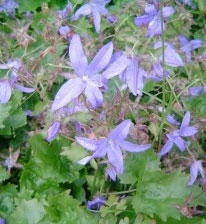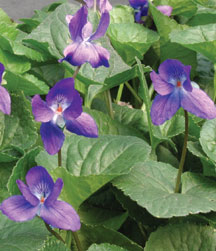UNDER CONIFER PURPLE POSIES: CAMPANULA VS. VIOLA
By Cassy Aoyagi: Finding a groundcover to thrive under conifers can be difficult in Southern California. Two groundcovers that can work are Campanula poscharskyana, a Mediterranean native, and Viola adunca, a California native. While plants from other LA-climate compatible regions of the world, like the Mediterranean basin, can thrive in California, this exchange is proof positive that California natives always have a home court advantage.

Campanula poscharskyana, or Serbian Bellflower, is native to the former Yugoslavia and used throughout Europe. It is now a staple ground cover in California. While lovely, Serbian Bellflower has:
- Low tolerance to extremes. Although it is native to mountainous ranges, Serbian Bellflower does not tolerate the extremes Southern California presents. A naturally moist area might drown this plant at certain times of the year, but in high heat supplemental water would be mandatory. While it is most likely to find what it needs under conifers, the situation where it truly thrives is rare. It needs a strong sun without out high heat and shade with bright light for it to thrive and spread.
- High maintenance needs. Serbian Bellflower prefers a harder cut back in winter to preserve its energy for the next season.
- Spotty seasons. Campanulas seasonal cut backs leave undesirable bare areas part of the year. Often times, I see this plant appearing very “spotty” in its landscape, thriving in the rare areas where its needs are met, while struggling in many others.
If you love the thought of having greenery and long-lived purple flowers dancing beneath your evergreens, there is a California native alternative to Campanula.
Viola adunca, very similar to Serbian Bellflower in appearance, is distributed throughout California from the coast to the desert and possesses strong advantages to thriving in its native region. Viola adunca:
- Thrives in California’s mountainous regions. In both desert and coastal climates, Viola adunca seeks higher altitudes (5000-11000), the shelter of evergreen forests, and seasonal marsh-like conditions. Although these conditions seem unlikely in Southern California, I regularly run into Viola-friendly microclimates in LA County and have had success with them at lower elevations, under evergreens, and in naturally moist, sheltered spots.
- Well-adapted to extremes. We struggle with ground covers that will take the shade and naturally occurring moisture, most everything, including baby tears is fussy and won’t stand the test of time, but unlike the rest, the Viola has adapted to take extreme and harsh conditions within its niche.
- Persistent color and blooms. An herbaceous perennial, Viola adunca spreads through underground rhizomes and makes a nice, thick mat of green, providing year round interest. It is all the more charming during the warmer months of spring through fall when light purple pansy-like flowers dance a few inches above the foliage.
- Provides fragrance and alternative benefits. While the seeds can be poisonous, Viola can also be used for tea and other medicinal purposes and is sometimes fragrant.
If you are considering adding Viola adunca to your landscape, Woodferns, Tiger Lilies, and Sedges make great teammates.
For more guidance on where to plant big dry ones, see our past Wet-to-Dry Exchange articles.
